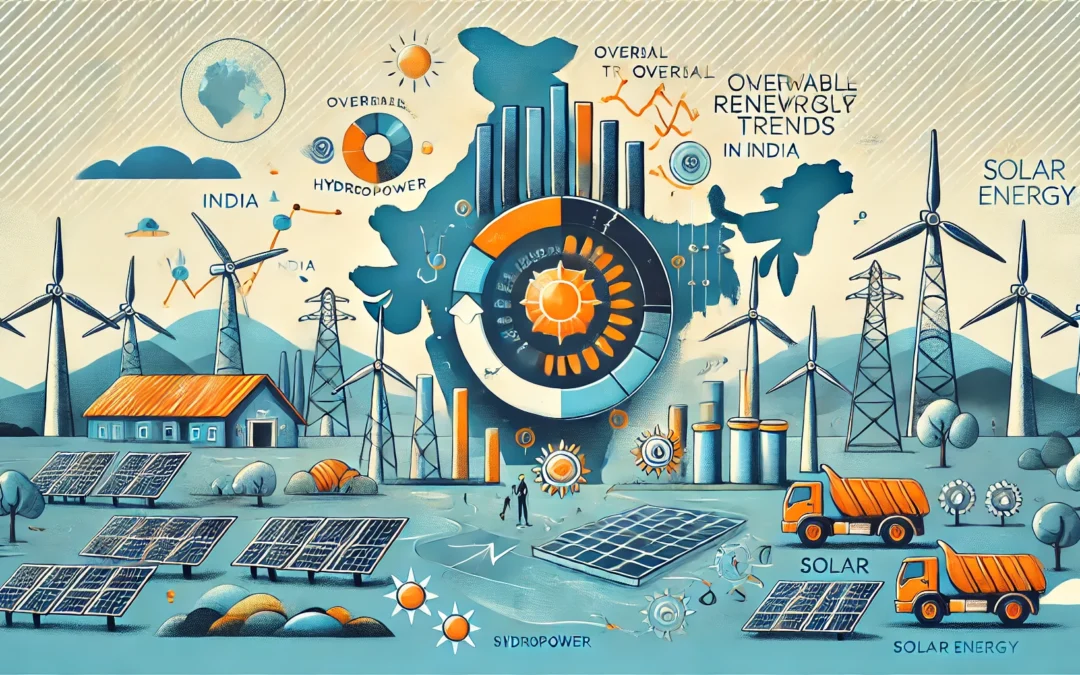India is making significant strides in its energy sector, particularly focusing on the shift from conventional energy sources to renewable energy (RE). Solar energy, in particular, has emerged as a key player within the renewable energy landscape. Below is a comparative analysis of the overall renewable energy trends versus solar energy trends in India.
1. Renewable Energy Trends in India
India has established itself as one of the global leaders in renewable energy. The country is making continuous efforts to diversify its energy mix, with a strong emphasis on increasing the share of renewable sources like wind, solar, hydro, and bioenergy.
Key Trends in India’s Renewable Energy Sector:
- Installed Renewable Energy Capacity:
- As of 2023, India’s total renewable energy capacity stands at approximately 125 GW, which includes solar, wind, hydro, and bioenergy.
- The government has set a goal of achieving 500 GW of non-fossil fuel energy capacity by 2030 to meet its climate and energy security objectives.
- Diverse Energy Mix:
- Wind Energy: India has a significant share of wind energy, with an installed capacity of over 42 GW. Coastal states like Tamil Nadu and Gujarat are leading in wind power generation.
- Hydropower: India’s hydropower potential is substantial, with a current installed capacity of over 46 GW. Large hydropower projects are crucial for balancing grid reliability and renewable energy integration.
- Bioenergy: India is harnessing bioenergy from agricultural waste, municipal waste, and biomass, contributing approximately 10 GW to its renewable energy capacity.
- Government Initiatives and Policies:
- National Solar Mission: Launched in 2010, the mission aims to make India a global leader in solar power. The focus has been on large-scale solar projects and promoting rooftop solar installations.
- Incentives and Subsidies: The government offers several incentives, such as capital subsidies, tax rebates, and accelerated depreciation, to promote investment in renewable energy.
- Emerging Technologies:
- Emerging Tech: India is exploring green hydrogen, pumped hydro storage, and smart grid integration to enhance RE capacity.
- Challenges: Issues like land acquisition, financing, and intermittency continue to affect large-scale deployment.
- Challenges:
- Grid Integration: The intermittent nature of renewable energy sources presents challenges for grid stability. Efforts are underway to modernize the grid and enhance energy storage solutions.
- Land Acquisition: Acquiring land for large-scale renewable energy projects, especially in densely populated areas, remains a challenge in India.
2. Solar Energy Trends in India
Solar energy is the most prominent segment of India’s renewable energy sector. India is one of the fastest-growing markets for solar energy, and the country is poised to be a global solar powerhouse.
Key Solar Energy Trends in India:
- Installed Solar Capacity:
- India’s installed solar power capacity exceeded 70 GW by the end of 2023. The country has set a target of 280 GW of solar capacity by 2030 as part of its broader renewable energy goals.
- India is ranked among the top 5 countries globally in terms of installed solar power capacity.
- Growth of Utility-Scale Solar:
- Large-scale solar parks are the backbone of India’s solar power generation. Projects like the Bhadla Solar Park in Rajasthan, one of the largest in the world, demonstrate India’s focus on utility-scale solar.
- States like Gujarat, Rajasthan, and Tamil Nadu are leading the country in solar capacity due to their vast land availability and high solar radiation.
- Rooftop Solar Boom:
- The rooftop solar market is growing rapidly, with a target of 40 GW of rooftop solar capacity by 2022. While India has yet to meet this target, the market is expanding in urban areas, commercial buildings, and industrial sectors. Reliable solar panel company in India provide turnkey solutions for homeowners and businesses.
- Government schemes like PM-KUSUM promote solar installations for farmers, incentivizing solar pumps and solar irrigation systems, especially for off-grid rural areas.
- Solar-Wind Hybrid Projects:
- Solar-Wind Hybrids are being deployed to enhance power consistency and grid performance.
- Innovations include:
- Bifacial PV panels that capture light on both sides
- Floating solar farms on reservoirs and canals
- Solar tracking systems that follow the sun for higher efficiency
- Cost Decline and Technology Advancements:
- The cost of solar energy has fallen dramatically in the last decade due to advancements in technology, economies of scale, and competitive bidding in government auctions. As of 2023, solar tariffs in India are some of the lowest globally, at around INR 2 per kWh.
- Advances in solar PV technologies such as bifacial solar panels, floating solar plants, and solar tracking systems are further driving the growth of solar energy in India.
- Solar Manufacturing and Domestic Production:
- To reduce import dependency, India is investing in local production under the PLI (Production Linked Incentive) scheme.
- This includes manufacturing solar modules, cells, inverters, and batteries.
- Solar Energy Storage:
- Solar power generation is being coupled with energy storage systems (ESS) like lithium-ion batteries. This integration addresses the intermittency of solar energy, providing backup power during non-sunlight hours and stabilizing the grid.
Comparison: Renewable Energy vs. Solar Energy Trends in India
| Aspect | Renewable Energy Trends | Solar Energy Trends |
|---|---|---|
| Installed Capacity | 125 GW overall (wind, solar, hydro, bioenergy) | 70 GW solar capacity (2023) |
| Growth Focus | Balanced focus on wind, hydro, solar, and bioenergy | Solar is the dominant growth sector with utility-scale and rooftop solar |
| Policy Support | National policies for various RE sectors; incentives for all RE types | Special focus on solar through National Solar Mission, PM-KUSUM, etc. |
| Cost Trends | Wind and hydro energy costs remain steady; bioenergy still evolving | Solar costs have dropped significantly, making it one of the cheapest energy sources |
| Challenges | Grid integration, land acquisition, financing | Land use, supply chain for domestic manufacturing, intermittency |
| Technology Focus | Wind-solar hybrids, green hydrogen, energy storage | Solar storage, advanced PV tech, floating solar, solar-wind hybrids |
| Future Targets (2030) | 500 GW total RE capacity | 280 GW solar capacity |

